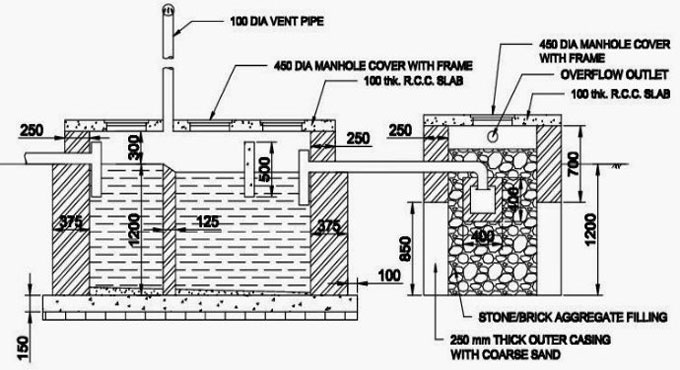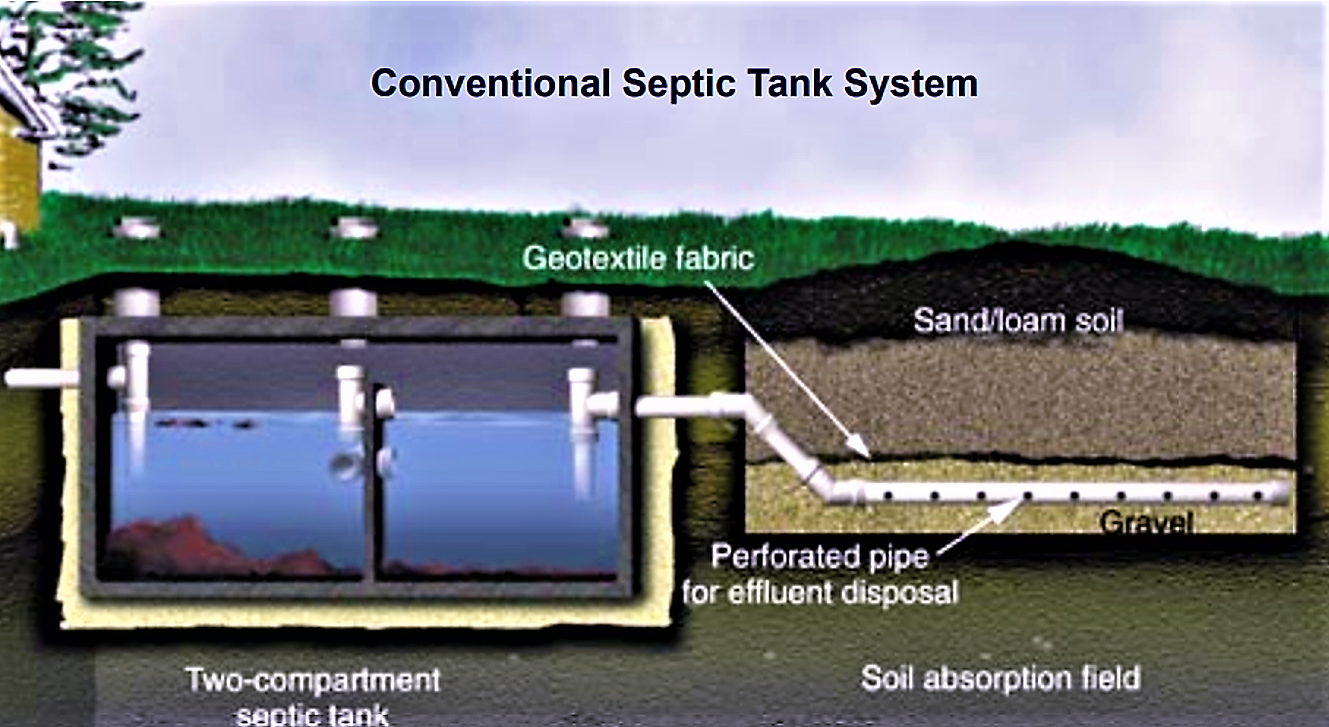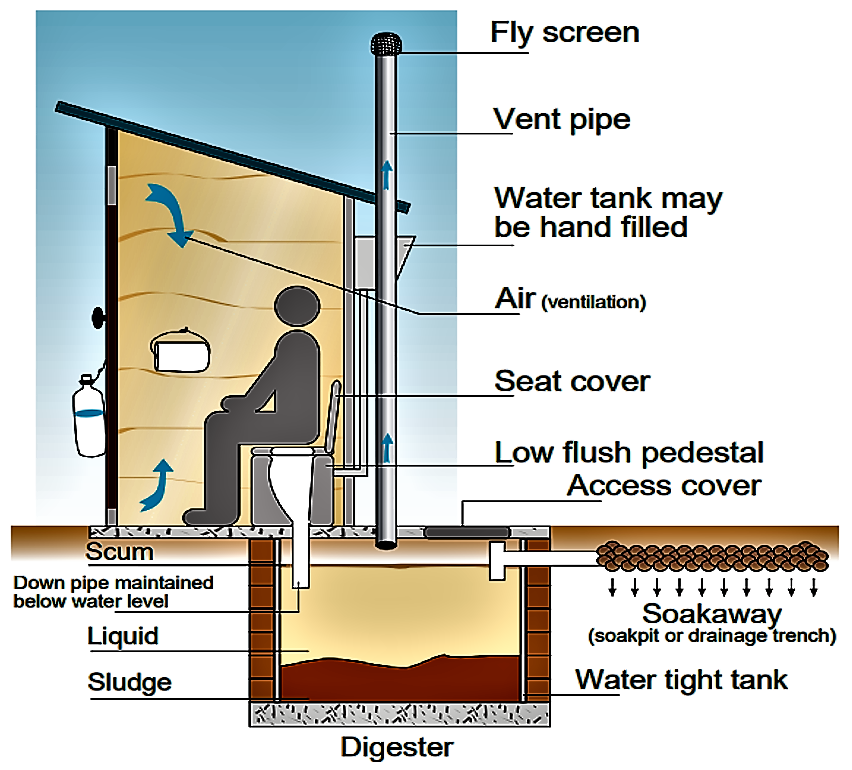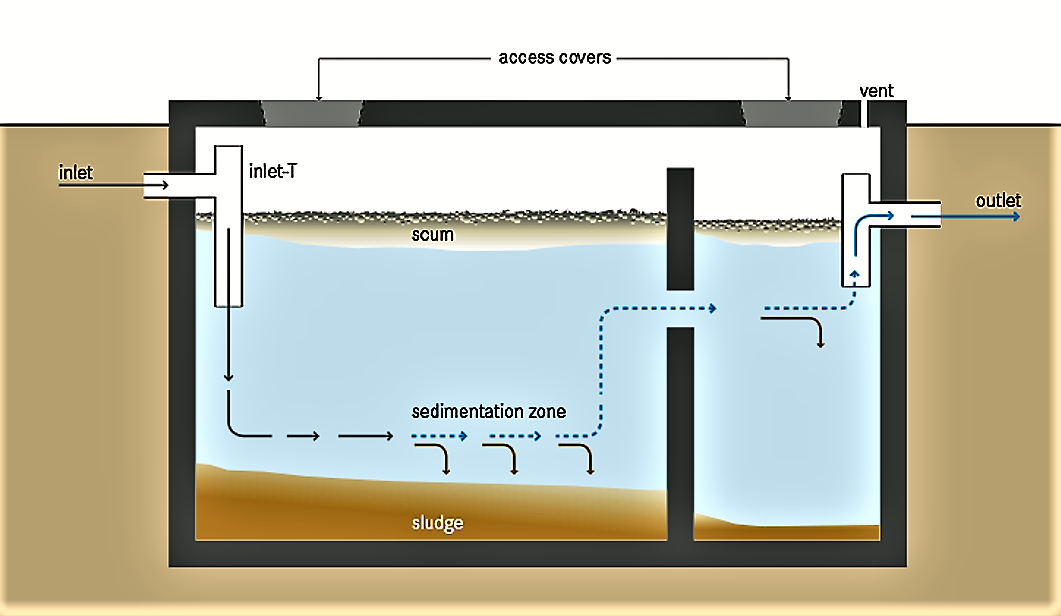how a septic tank works pdf
Septic tank The septic tank is a buried watertight container typically made of concrete fiberglass or polyethylene. Primary treatment in a septic tank involves the following mainly physical but also some chemical and biological processes which are further described below.

Septic Tank Design Specifications Septic Tank Design Calculations
DESIGN AND CONSTRUCTION STANDARDS FOR SEPTIC TANKS SOIL ABSORPTION SYSTEMS AND OTHER SMALL WASTEWATER SYSTEMS Section 1.

. It typically consists of a septic tank with an effluent filter and a drain field or a soil absorption field. The numbers listed below correspond to the numbered steps shown in the figure below. Components of septic system 1 Connecting Pipe.
The rate of flow of. Greater reductions occur when the septic tank is compartmentalized. As seen in the septic tank diagram once the waste is sorted into its three main types the wastewater is then extracted from the tank through the outlet pipe for further treatment or disposal.
Most cities have a map with all the septic tanks that have been installed in that area. This is the first step that should be taken as it is easiest. Currently more than one-third of the nations wastewater treatment is provided by septic tank systems.
A gravity-septic tank and the soil absorption field. The septic tank may be the. SEPTIC TANK A septic tank is a chamber which is either brick built or of a proprietary glass fibreplastic construction which provides an environment for solids to settle and possibly undergo anaerobic decomposition.
The scum composed of waste thats lighter than water floats on top. 1 Connecting Pipe 2 Inspection Chamber 3 Septic Tank 4 Soak Pit Figure 1. The minimum diameter of the pipe should be 4 inches.
A septic system consists of four main components. Use a septic tank map. Diagram of a septic tank.
The septic tank provides the first step in treatment. How Does a Septic Tank Work. Up to 50 of.
The septic tank removes solids by holding wastewater in the tank for at least 24 hours allowing the solids to settle and scum to rise to the top. Sedimentation solids flotation scum clarification anaerobic digestion organic material. As the septic system is used there is an accumulation of solids in the tank which is sometime referred to as sludge.
Solids effluent and scum see illustration above. Through a pipe to the septic tank. How Do Septic Tanks and Septic Systems Work.
The septic tank is a buried water-tight container usually made of concrete fiberglass or polyethylene. How large should my septic tank be. Its job is to hold the wastewater long enough to allow solids to settle down to the bottom forming sludge while the oil and grease floats to the top as scum.
The tank is also fitted with inspection pipes which allow qualified plumbers to inspect critical parts of the septic tank design. Further reduction occurs as the effluent comes in contact with bacterial growth in the leaching system and the aerated soil zone above the ground water table. It also allows partial decomposition of the solid materials.
It holds the wastewater long enough to allow solids to settle out form-ing sludge and oil and grease to float to the surface as scum. I Length Width and Depth of Septic Tank Width 750mmmin Length 2 to 4 times width Depth 1000 to 1300mm. Compartments and a T-shaped outlet prevent the sludge and scum from leaving the tank and.
How Do Septic Tank Systems Work. This map should show you the exact location of it. A properly functioning septic tank will reduce the BOD in the effluent by about 25 to 30 percent.
How a septic tank works is fairly simple. System DescriptionA septic tank system uses natural processes to treat and dispose of the wastewater generated in your home. How the system works The septic tank.
When the wastewater enters the tank it will settle to the bottom in three layers. Annual inspections of your septic system are recommended to ensure that it is working properly and to determine when the septic tank 2. A septic tank is a large underground watertight container typically about 9 feet long 4-5 feet wide and 5 feet tall that is connected to the homes sewer line.
The tank is connected with two pipes for inlet. If you have not been able to find a map the easiest way to find a septic tank is to follow the pipes. A septic system has a simple design.
This video was developed by Judith Torzillo for Healthabitat to help explain the process of how a septic tanks works what the by products are good for and. The Wyoming Environmental Quality Act WS. Septic tank and drainfield soil absorption system following the septic tank for onsite wastewater management figure reproduced with permission of Purdue.
The solids settle to the bottom where microorganisms decompose them. Septic tanks work by allowing waste to separate into three layers. Septic system works is the first step in understanding how other types of septic systems work.
This regulation is promulgated pursuant to the Wyoming Administrative Procedures Act WS. A septic system works by allowing waste water to separate into layers and begin the process of decomposition while being contained within the septic tank. The septic tank is a water-tight container usually made of concrete fiberglass or polyethylene typically buried underground.
It is an underground watertight container mostly rectangular or round made of fiberglass plastic or concrete. Min below water level 300 to 450mm free board Maximum depth 1800mm 450 mm free board Capacity 1 cubic meter 10 cubic feet minimum ii Detention period Detention period of 24hrs mostly considered in septic tank design. This allows your wastewater to be retained long enough to allow the settling out of solids and liquids encouraging treatment and microbiological activity.
In the province of Ontario the capacity of a household septic system is intended to accommodate twice the daily design flow of your home. Sewage from the home enters the septic tank. Its function is to store the wastewater long enough to allow solid wastes to settle down to the base of the tank sludge layer and lighter wastes like oil and grease float to the top scum layer.
A septic tank must be able to retain the maximum 24 hour design flow to optimise. The wastewater from the toilet flows to the septic tank through the connecting pipe. This is accomplished by a series of baffles inside the tank.
Septic system maintenance is often compared to automobile mainte-nance because only a little effort on a regular basis can save a lot of money and significantly prolong the life of the system. Scum Layer Effluent Sludge Layer All the grease and oil that is sent through the drainpipe will wind up in the scum layer which sits on top. The Septic Tank The septic tank is an enclosed receptacle designed to collect wastewater segregate settleable and floatable solids sludge and scum accumulate consolidate and store solids digest organic matter and discharge treated effluent.
While typically designed with a 1000-gallon liquid capacity the size of the tank is legally determined by the number of bedrooms in the home.

Ppt Plumbing Design Ronel Descarga Academia Edu

How Septic Tanks Work And When To Empty Them Septic Tank Design Septic Tank Septic Tank Systems

Septic Tank Additives Clark County Washington State University

Septic Tank Components And Design Of Septic Tank Based On Population Septic Tank Design Septic Tank Septic Tank Systems

Designing A Septic Tank Septic Tank Construction Methods Engineering Feed Septic Tank Design Septic Tank Septic Tank Systems

Why Do I Need To Clean My Septic Tank Every Three Years Safe Food Water

Modified Septic Tank Anaerobic Filter Unit As A Two Stage Onsite Download Scientific Diagram

Septic Tank Detail Design Drawing Septic Tank Design Septic Tank Plumbing Design

Residential Sewage Treatment Plants Packaged Onsite Septic System Designs Cluster Step Individual Sewage Treatment Plants

Septic Tank Sswm Find Tools For Sustainable Sanitation And Water Management

Septic Tank Design Details Septic Tank Design 3 Chambers How To Build A Septic Tank Concrete Hpd Team Septic Tank Design Septic Tank Concrete Septic Tank

Septic Tank Sswm Find Tools For Sustainable Sanitation And Water Management

How Does A Septic Tank Work Diy Family Handyman
Septic Tank Design Septic Tank Construction Standard Sizes Of Septic Tanks

Septic Tank Sswm Find Tools For Sustainable Sanitation And Water Management


